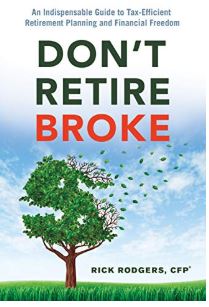Planning a tax-efficient retirement income is easier when you understand the R/D Factor and how to use it to minimize taxes. The R/D Factor (R/D = retirement distribution) is a measure of the New Three-Legged Stool strategy for retirement. This strategy is based on balancing your savings between tax-deferred, after-tax, and tax-free accounts. The scale runs from 0 to 100, with 100 meaning all retirement distributions are tax-free and 0 meaning all distributions are taxable.
Why Balancing Your Savings Matters
Unwisely, many people today aren’t concerned with balancing their savings. They simply save money in their company’s tax-deferred savings plan and spend everything else. The problem with this approach manifests itself at retirement. Every dollar distributed from a tax-deferred account is taxable. The goal should be to retire with the maximum flexibility in your savings. A retiree may be able to choose how much tax (if any) to pay on their retirement distributions by choosing which account to withdraw it from. From this perspective, the R/D Factor is a measure of the level of flexibility in your retirement savings.
The New Three-Legged Stool approach to retirement planning balances your savings so you can maximize the R/D Factor. Tax liability from after-tax accounts is not based on the amount of withdrawal. It is based on how the money is earned. Earnings classified as long-term capital gains or qualified dividends may be taxed at a zero rate if you plan your income properly. Distributions from tax-deferred accounts have the worst tax implications and must be planned carefully. Roth IRA distributions have no tax implications and are used to supplement your income when needed without concern from income taxes.
The Importance of Income Flexibility
A taxpayer’s Modified Adjusted Gross Income (MAGI) in retirement impacts whether Social Security benefits are taxable or tax-free as well as the amount of a retiree’s monthly Medicare premium. Taxpayers with higher incomes are also subject to a Medicare sur-tax on income over a certain threshold. I believe we could be approaching a time when the IRS will be even more aggressive in taxing these assets. Social Security may eventually be means tested based on other income. Planning for retirement should be diversified over the three types of accounts to provide flexibility when needed.
The R/D Factor scores retirement savings based on the taxability of distributions. The scale runs from 0—the point that a distribution is all taxable—to 100, meaning the entire distribution is tax-free. A Roth IRA account would mostly likely be scored at 100. A tax-deferred account, like a traditional IRA or 401(k) that holds all pre-tax money, would be scored at 0. Scoring taxable accounts will depend on whether funds are held in tax-free municipal bonds or stocks. The unrealized gains on the stocks would affect scoring. A reasonable goal could be to reach an R/D Factor between 40–60, which indicates a balanced New Three-Legged Stool.
The R/D Factor should be reviewed regularly as the financial markets change and individual tax circumstances present opportunities. Taxable income could be accelerated in low tax years. Higher income years may require minimizing taxable income to stay in a lower tax bracket. Monitoring your R/D Factor as you are saving for retirement could help avoid ending up like the countless retirees who pay income tax on every dollar they withdraw.
The New Three-Legged Stool approach to retirement planning is about balance and diversification. Saving all your money in tax-free accounts would score an R/D Factor of 100. Then all retirement distributions would be non-taxable. However, there is a two-fold problem with making 100% tax-free savings the goal:
- There are immediate tax benefits to using IRA and 401(k) accounts that should not be ignored. Annual tax planning should take into consideration the level of pre-tax savings needed to stay in a lower tax bracket. Itemized deductions are reduced based on total adjusted gross income (AGI). Alternative Minimum Tax (AMT) calculations are also based on AGI. Pre-tax savings accounts are often the only tool taxpayers have available to minimize the AMT burden.
- There are limits to how much can be put into a Roth IRA and/or Roth 401(k). Some taxpayers can only contribute to a Roth using the two-step approach of non-deductible IRA contributions first. Even using these strategies, it would still be difficult to put 100% of retirement savings into a Roth without ignoring some significant tax issues.
The ideal goal is to balance savings over all three legs of the stool. Take advantage of tax saving opportunities today while planning for tax saving opportunities in the future. Tax laws change frequently. Incentives in the tax code today may not exist next year. Maximizing the flexibility of your retirement savings could help you prepare for future tax law changes, whatever they may be. Read Rick’s original post here.
Rick’s Insights:
- The R/D Factor is the percentage of your retirement distributions that won’t be taxable.
- You should strive for a R/D Factor of 40-60.
- Balance is the goal—do not neglect tax saving opportunities today when building your New Three-Legged Stool.
By Rick Rodgers
Read more from Rick Rodgers by clicking here to purchase his book.
 Don’t Retire Broke:
Don’t Retire Broke:
An Indispensable Guide to Tax-Efficient Retirement Planning and Financial Freedom, by Rick Rodgers
Using easy-to-understand language and real life examples, Rick teaches you how to avoid savings pitfalls and costly tax mistakes – many you may not even know about – so you can enjoy the retirement lifestyle you want.


